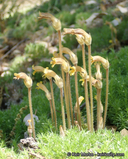Taxon Report
Aphyllon epigalium Colwell & A. C. Schneid. ssp. notocalifornicum Colwell & A. C. Schneid.Southern California galium broomrape |
 Keir Morse |
Taxon Summary
Aphyllon epigalium ssp. notocalifornicum, commonly known as Southern California galium broomrape, is a annual/perennial herb (parasitic) in the Orobanchaceae that is found only in California. It occurs within Cismontane woodland, Lower montane coniferous forest, and Riparian forest, growing at elevations from 1200 to 1535 meters. Aphyllon epigalium ssp. notocalifornicum is ranked 1B.3, Plants Rare, Threatened or Endangered in California and Elsewhere; Not very threatened in California.Classification
|
Scientific Name: |
Aphyllon epigalium Colwell & A. C. Schneid. ssp. notocalifornicum Colwell & A. C. Schneid. |
|
Common Name: |
Southern California galium broomrape |
| Family: | Orobanchaceae |
| Element Code: | PDORO05012 |
| USDA Plants Symbol: | |
|
Synonyms/Other Names: |
|
Ecology and Life History
| Lifeform: | annual/perennial herb (parasitic) |
| Blooming Period: Jun(Jul) | Jun(Jul) |
| Elevation: | 1200-1535 (3935-5035) |
| General Habitats: | Cismontane woodland, Lower montane coniferous forest, Riparian forest |
| Microhabitat: | |
| Microhabitat Details: | Associated host is Gallium andrewsii and possibly other perennial Galium spp. Most records are from stands of Pseudotsuga macrocarpa. |
Conservation Status
| CA Rare Plant Rank: | 1B.3 |
| Global Rank: | G4T2 |
|
State Rank: |
S2 |
| State List: | None |
| Fed List: | None |
| Other Status: | |
|
CRPR Changes: |
|
Occurrence Data from the CNDDB
| Total Occurrences: | 8 |
| Element Occurrence Ranks: | |
| Excellent (A) | 0 |
| Good (B) | 0 |
| Fair (C) | 0 |
| Poor (D) | 0 |
| None (X) | 0 |
| Unknown (U) | 8 |
| California Endemic: False | |
| California Counties and Islands: Name (Code) | |
| San Bernardino (SBD), San Diego (SDG), Ventura (VEN) | |
| Quads: Name (Quad Code) | |
| Boucher Hill (3311638), Cuyamaca Peak (3211685), Forest Falls (3411618), Palomar Observatory (3311637), Vail Lake (3311648), White Ledge Peak (3411944), Yucaipa (3411711) | |
Threat List Data from the CNDDB
| Threat List Total: | 0 | |
| EOs with Threat Listed: | Total EOs | % of EOs |
| 0 | % | |
|
|
||
Notes
|
While Colwell et al. (2017) include May in the flowering time, no May records were found. |
|
Threats: |
|
Potentially threatened by improper burning regime. |
|
Taxonomy: |
|
Previously identified as either A. fasciculatum or (sometimes) A. purpureum; differentiated by its growth on Galium and the presence of 2-4 yellow flowers per stem with pedicels longer than the stem. Differentiated from A. epigalium ssp. epigalium by its paler, straw-colored flowers and shorter corollas with more prominently arched tubes, +/- horizontal mouths, and narrower lobes with erect or weakly recurved tips. |
Selected References
| Proposed addition to CRPR 1B.3, G4T2 / S2 (2023) |
| Madroño 64(3): 99–107 (2017) |
Citation
California Native Plant Society, Rare Plant Program. 2025. Rare Plant Inventory (online edition, v9.5.1). Website https://www.rareplants.cnps.org [accessed 23 December 2025].